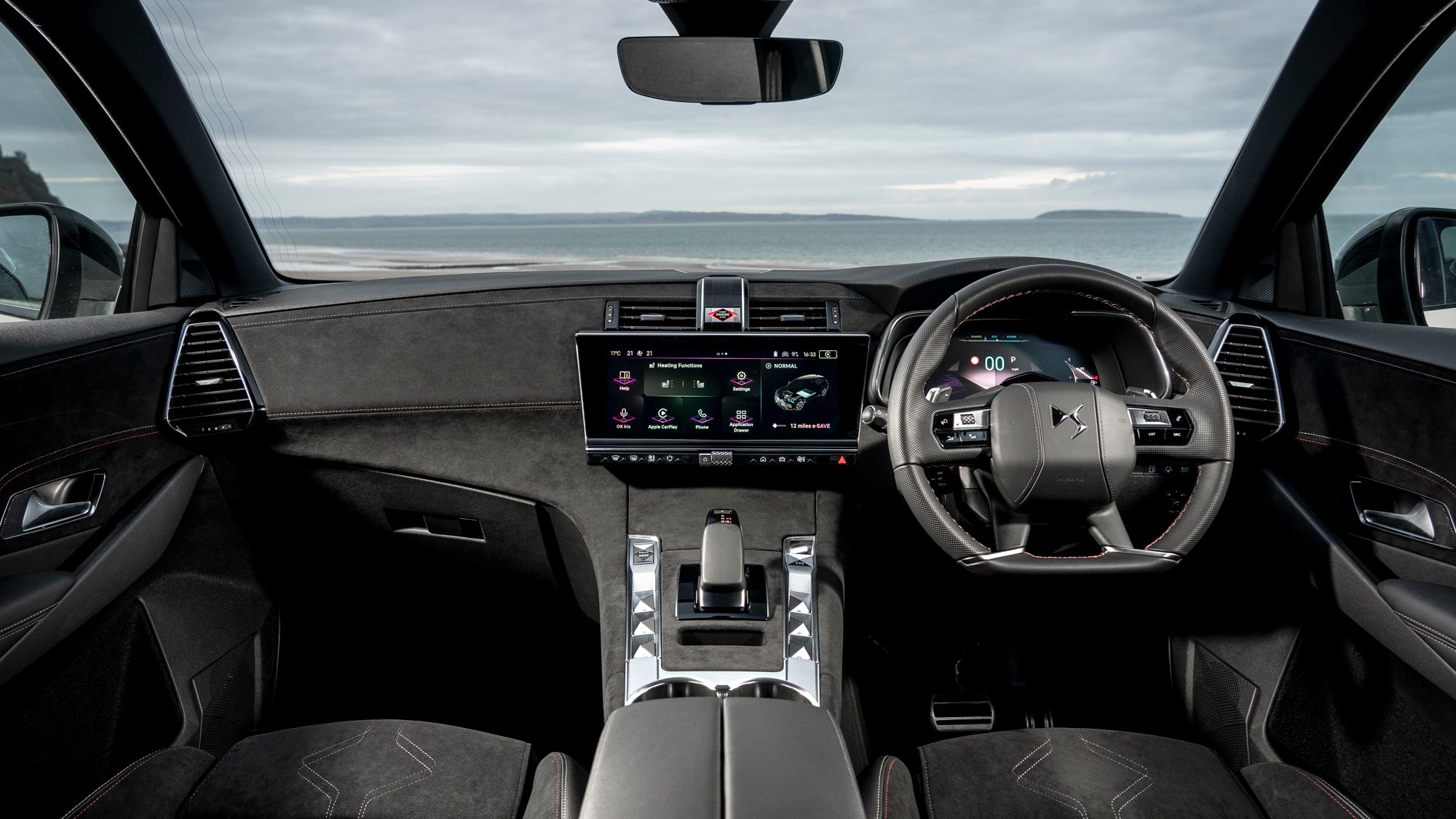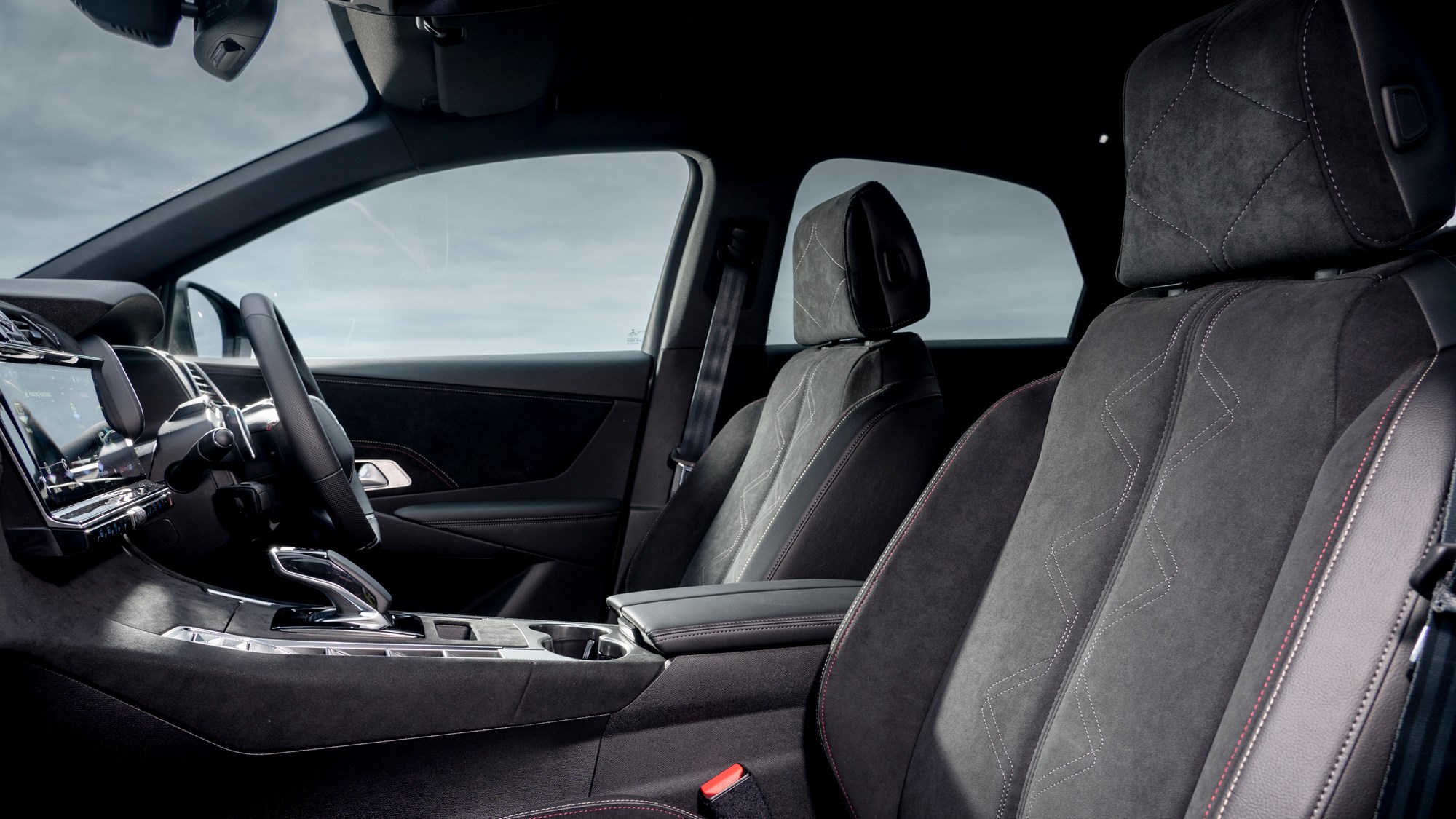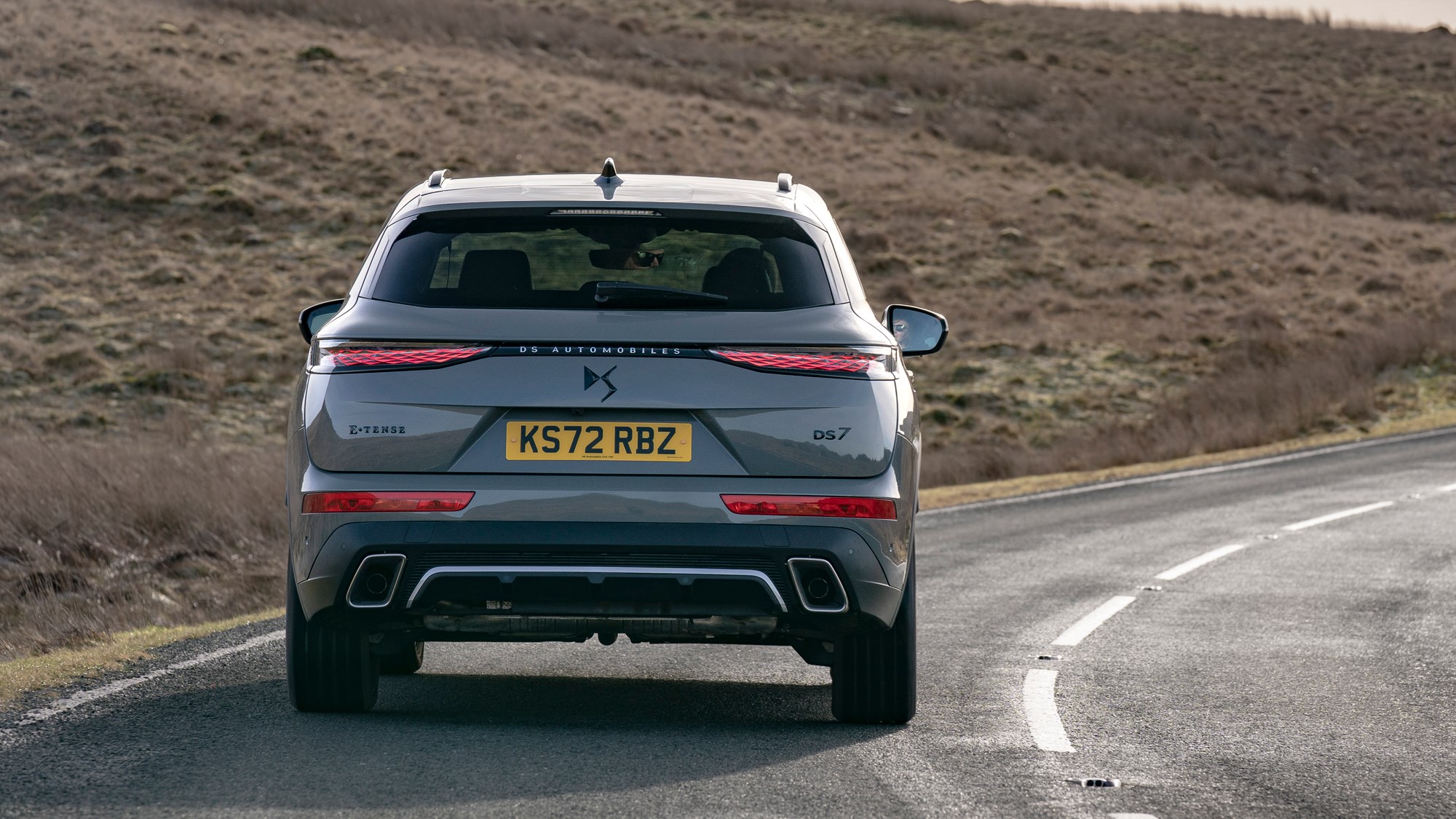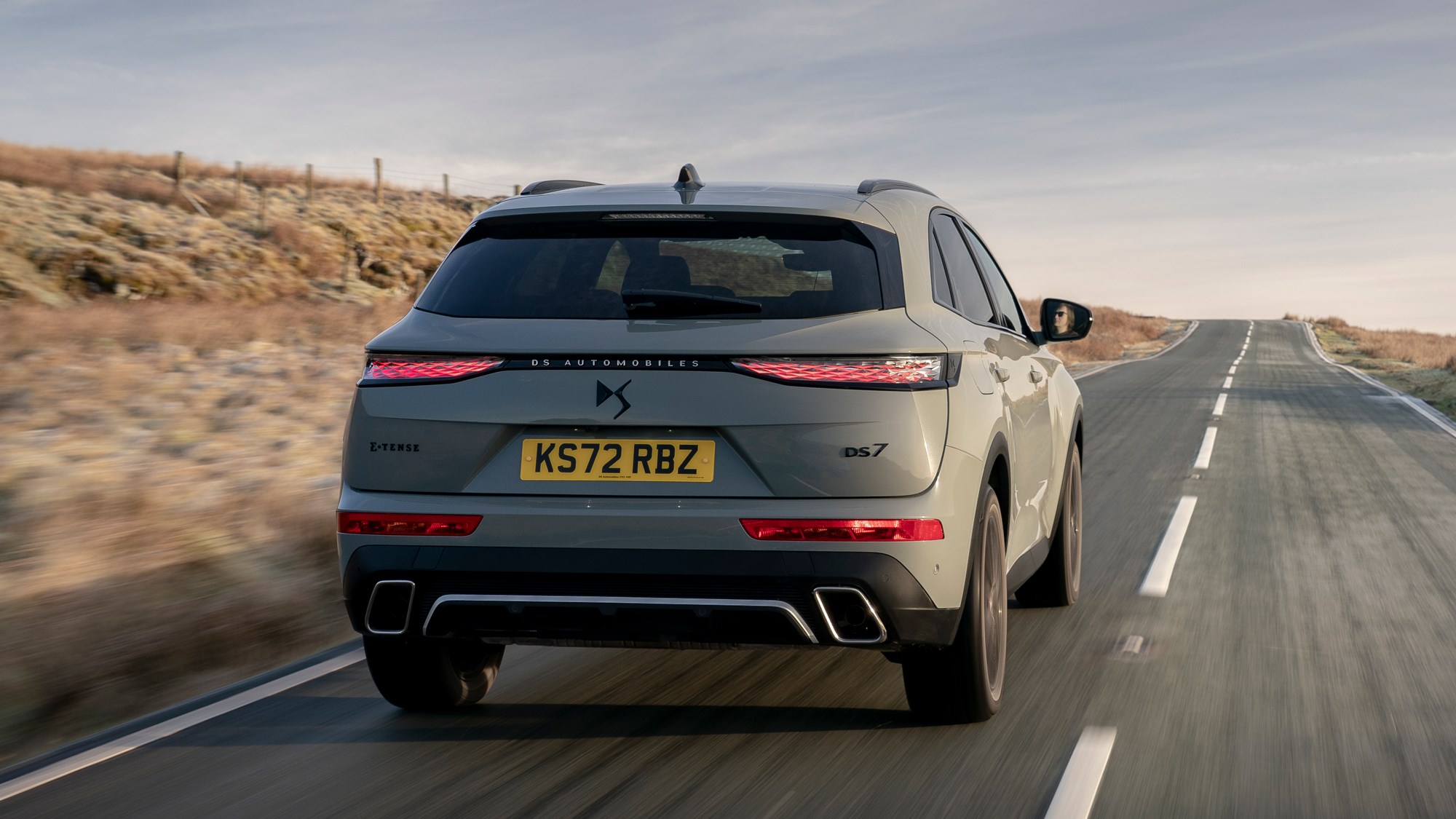► Facelifted flagship DS SUV tested
► Top-spec PHEV model has 355bhp
► But is it more style than substance?
Since it parted ways with Citroen in 2014, DS Automobiles has been working hard to establish itself as a premium brand. We’d say it’s now reached household fame. The company has tipped skip-loads of cash into its Formula E campaign to push its branding into our living rooms – and now, the firm has outlined an aggressive electrification strategy that will see it become an EV-only manufacturer by 2026. That’s sooner than any of the big German brands.
The facelifted DS 7 plays a key role in that electrification strategy. Until DS ousts petrol and diesel power from its range, it still needs an attractive car to sell – preferably one that can square up to the likes of BMW, Audi and Mercedes while also upholding the firm’s environmental goals.

So, for its mid-life refresh, the DS 7 received a striking makeover with a massive new radiator grille and unusual set of ‘light veil’ daytime running lights that DS hopes will drag buyers away from its ever-more outlandishly styled German rivals. The 7’s PHEV system has also been improved with a larger 14.2kWh battery pack, which has bumped up its maximum electric range from 34 to 43 miles. Oh yes, and DS chiselled off the previous model’s ‘Crossback’ nameplate, too.
As part of the facelift, DS also introduced a new performance-focused E-Tense 4×4 360 model with 355bhp and 384lb/ft of torque. That gives this (rather heavy) family SUV the same 0–62mph time as Volkswagen Golf GTI Clubsport. Drive it with a little more care, though, and DS says you’ll be able to extract up to 161mpg from the system.
If you want something a little more moderate, there are a further two plug-in hybrid systems to choose from. The cheapest front-wheel drive PHEV option has 222bhp, while the mid-range option has a more powerful engine tune and an extra motor on the rear axle that increases power to 296bhp. The latter option is also the entry-point for four-wheel drive.

If you can’t be bothered with charging cables, though, DS will still sell you a pure combustion-engined version of the 7. But it’s a diesel – and that seems a little out of step with the company’s environmental goals. Still, it should at least be reliable. It’s a 129bhp version of the 1.5-litre four-cylinder unit found in everything from the Peugeot 3008 SUV to the Citroen Dispatch van.
The question is – are the changes enough to make the DS 7 a credible rival for the likes of the Audi Q3, BMW X1 and Mercedes GLA? Or is it a classic case of style over substance? To find out, we’ve spent some time in the range-topping DS 7 E-Tense 4×4 360. Scroll down to see how it stacks up.
What’s it like inside?
It certainly looks the part – and, providing you don’t scrutinise the cabin too closely, it feels suitably distanced from its more affordable Stellantis stablemates. You get plenty of premium touches, such as sumptuous ‘watch strap’ leather upholstery, lashings of soft-touch materials and a pair of high-resolution screens, including a widescreen 12.0-inch unit for the infotainment system.
The cabin has a quirky layout. Unlike almost every other SUV on sale, there aren’t any buttons on the door panels. The controls for the electric windows and door locks are mounted on the centre console in two rows of angular rocker switches. Most importantly, given DS’s premium image, you won’t find these buttons in any other vehicle from Stellantis.

You get a couple more brand-specific trims, such as the knurled aluminium volume tumbler and a diamond-shaped start button in the middle of the dashboard. We appreciate the effort – but once you start to look closer, you can see where corners have been cut.
The gear selector has been transferred wholesale from the Vauxhall Corsa, while the door handles and steering wheel are identical to the units found in the Citroen C4. We get that Stellantis is just trying to maximise its assets, but we think it’s a shame that components from much cheaper cars have been used on such common touchpoints.
But is it practical?
Here’s where the DS 7 redeems itself. There’s plenty of space inside, with ample head and legroom in the front and rear. The rear seats can also recline, which promises to ease back pain for those relegated to the bench on longer journeys.

Boot space is good, too. Rival plug-in hybrid SUVs like the Toyota RAV4 and Kia Sportage sacrifice some boot space for the additional electrification – but not the DS 7. Both the diesel and PHEV versions offer 555 litres of luggage space with the bench upright and 1,752 litres with it stowed.
That puts it slap-bang in the middle of the compact premium SUV class, ahead of the BMW X1 but behind the cavernous Land Rover Discovery Sport.
It’s a big French barge. So, surely, it’s comfortable?
Erm. It’s comfortable-ish. We’ll start with the good bit – the seats. Every version of the DS 7 (apart from the most basic Performance Line model) features electrically adjustable and heated front seats. If you opt for the flagship La Premiere variant, you also get air-conditioning and massage functions.
They’re all comfortable, finding an equilibrium between softness and support. We’re particularly fond of DS’s stretch massage function, which we found to be great at preventing our joints from seizing up on the motorway.

But the chassis on the four-wheel drive plug-in hybrid versions lets the side down. They’re fitted with DS’s Active Scan Suspension, which uses a camera mounted behind the rear-view mirror to scan the road ahead for imperfections. The data it the camera gathers is sent to the dampers, which are pre-loaded to suit the upcoming dents with the aim of improving ride quality.
The system sounds great in theory, but it’s less impressive in practice. Perhaps the lowered suspension on our sporty E-Tense 4×4 360 test car was to blame, but it didn’t feel like the system was working. The DS 7 jiggles over low-speed pockmarks and drops heavily into high-speed craters, which spoils the interior ambiance. If ride is of paramount important to you, the Germans do it better.
What’s it like to drive?
The E-Tense 4×4 360 is quick. The torque from the electric motors is instant. Overtake something at full throttle and you get a very satisfying shove in the small of your back until the petrol engine comes on song and launches you past your victim. It’s hilarious – it’s supposed to be a comfortable French SUV, but it can show the best hot hatchbacks a clean pair of heels in a straight line.
Just don’t rely on the computers for the best performance. The automatic gearbox controller is quite slow to responds so, if you want the best results, you need to take manual control using the paddles behind the wheel. Just make sure you execute your overtake quickly because there isn’t an option to lock the gearbox in manual mode. The software will shift back up to eighth gear if you dawdle.

However, if you use the available performance too often, you’ll chew through the car’s battery capacity faster than a pubescent teenager empties plates at an all-you-can-eat buffet. But engaging both regen and sport mode can help you claw back some of that power. We managed to return 3 miles of electric range to the battery once we emptied it, just by driving.
Sadly, the chassis doesn’t really do the powertrain justice. Because the E-Tense 4×4 360 is so much faster than the other variants, DS fitted it with lowered suspension, bigger brakes and larger 21-inch alloy wheels shod in stickier tyres. The new brakes offer impressive stopping power but, as we touched on above, the suspension tweaks make the SUV less comfortable – and the larger alloys only make matters worse. It certainly hasn’t been transformed into a Lotus in the corners.

If we’re honest, the DS 7 wasn’t the best starting point for a performance SUV. Even the standard PHEV models struggle to cope with the weight of the hybrid system when you throw it through a series of bends – and piling on an extra 60bhp isn’t going to remedy that.
Push the 7 hard into a corner and the front wheels will find the limit of grip far sooner than a BMW X1 – and the car will wash wide of the apex. The steering also isn’t precise enough to let you enjoy a B-road. It’s better suited to pottering around town or cruising along the motorway. It isn’t unsafe by any stretch of the imagination, but it certainly isn’t a driver’s car.
Verdict
If you want a stylish and unusual premium SUV, the DS 7 could serve you very well. It looks the part, but there are better options out there that offer a more engaging driving experience, a better ride and a higher-quality interior. We’re not sure the new performance powertrain suits the car’s character, either – although it is blisteringly quick in a straight line.
Don’t get us wrong, the DS 7 isn’t totally unrecommendable. You just need to be clever about how you spec it. Opting for one of the less potent PHEV powertrains (without the lowered suspension and enormous alloy wheels) improves the driving experience greatly – and it also nets you better fuel economy and the longest electric-only range.
Every version of the DS 7 is roomy and well-equipped, too. We also like that DS has fitted a few unique pieces of trim to its interior, although you’ll start to pay more attention to parts in the cabin that are shared between less expensive Stellantis cars after your first week of ownership.
Option it tastefully and you’ll have a comfortable, stylish and spacious cruiser. But you’ll taint the experience is you simply tick every option on the order form.
